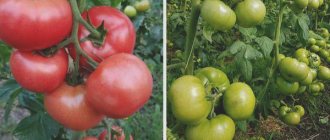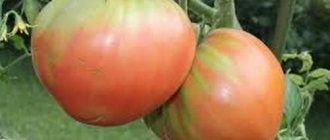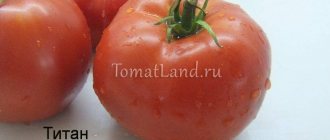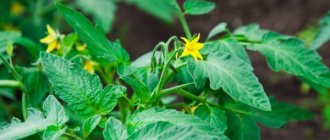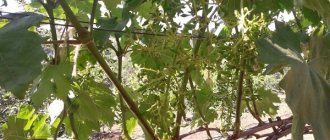Author's rating
Author of the article
Yakov Pavlovich
Professor, Head of the Department of Vegetable Growing
Articles written
153
Judging by the reviews of gardeners, the Pink Souvenir tomato is extremely popular, as it is characterized by high productivity. This variety, in its characteristics, stands out noticeably from the rest. And despite the fact that it is not one of the new products, it can compete with more modern types, and in some respects even surpasses them.
Varietal characteristics
The Pink Souvenir tomato is one of the pink-fruited species, which is why it got its name. It is a hybrid form of culture, so it will not be possible to collect planting material on your own. But, despite this, many gardeners prefer to plant Pink Souvenir on their plot. Therefore, you should understand what advantages it has.
History of selection
This hybrid was bred more than 15 years ago. Its originator is the joint stock company “Sortsemovoshch”. The company specializes in the development of new types of tomatoes for cultivation in the Leningrad region and the North-West region of Russia. But, despite this, the hybrid Pink Souvenir is zoned everywhere, and it can be grown in all regions.
The Pink Souvenir tomato was included in the State Register in 2004 and is recommended for cultivation in open ground.
Main characteristics of the Pink Souvenir variety
This hybrid is one of the early ripening species. Harvesting can be done 80-85 days after sprouts appear.
Bush
Tomato Pink Souvenir is characterized by low-growing bushes. This species is determinate, so the growth of its shoots is limited. The height of the bushes does not exceed 60 cm. The shoots are densely leafy, so sunburn does not appear on the fruits even in the hottest periods of the year.
The leaves of the Pink Souvenir are medium in size and light green in color. The inflorescences are simple. The first fruit cluster is formed above the 5-7th leaf, and the subsequent ones - after 2. Up to 7 tomatoes are formed on each of them.
Productivity and fruits
Pink Souvenir tomatoes have a regular round shape. The average weight of each is 80-120 g, but individual specimens weigh 150 g. When ripe, the tomatoes acquire a uniform pink color with shine. This species is distinguished by its friendly yield of fruits.
Note! Pink Souvenir tomatoes do not have a green spot on the stalk, which is common to many species.
The pulp is sugary, the skin is thin and dense. Pink Souvenir has a pleasant sweetish taste with a slight sourness. The yield is 8 kg per 1 sq. m.
This hybrid belongs to the salad category, so the fruits are recommended to be consumed fresh. The Pink Souvenir can also be used for recycling. You can make sauces, pastas, and salads from tomatoes.
Note! Pink Souvenir tomatoes are resistant to cracking.
Immunity to diseases
This hybrid is characterized by relative resistance to common crop diseases. Therefore, it requires preventive treatment of bushes throughout the season.
It is recommended to start spraying the bushes 10 days after planting in a permanent place, and repeat every 2 weeks.
Benefits of growing rose fruits
Most consumers are familiar with the taste qualities that tomatoes have. The pink fruit has a sweeter, richer taste and is suitable for both fresh eating and canning. The first varieties of pink tomatoes developed were less productive and required very careful care, but at the moment a large number of varieties have been developed that have good yields. Pink tomatoes require attention just like red ones.
A significant contribution to the development of new varieties was made by breeders from the Volgograd, Samara regions and Krasnodar Territory. Among the advantages of pink tomatoes, it is worth noting their presentation and taste, which is important when growing vegetables for sale.
Pros and cons of growing
Like all species, the Pink Souvenir tomato has strengths and weaknesses. Therefore, before making a final decision, you need to familiarize yourself with them.
Advantages of the Pink Souvenir:
- high productivity;
- friendly ripening of fruits;
- easily tolerates transportation and long-term storage;
- excellent taste;
- excellent presentation of tomatoes;
- increased content of nutrients in tomatoes;
- able to set fruit even at temperatures above +30 degrees;
- easily tolerates changes in temperature and humidity;
- versatility of use;
- tomatoes are resistant to cracking.
See also Tomato variety Big Beef: characteristics of the variety and features of growing in a greenhouse
The disadvantages of this hybrid include the fact that the bushes need support, since when the fruits ripen, the bush may tilt. It is also necessary to partially plant the plants up to the first flower cluster.
Tomato Pink Honey
If you like large tomatoes, and even the seeds of which you can prepare yourself, then this variety is for you. Bred in Russia, it was specially created for the middle zone of our country.
In greenhouses, bushes can stretch more than a meter, but without shelter they do not grow higher than 70-80 cm.
The fruits (weighing from 600 g to 1.5 kg) ripen in 110 days. They are shaped like a heart. But they will be very large only on the first brushes of the plant. As with other large-fruited varieties, the harvest becomes smaller as new tomatoes grow.
Landing
This hybrid can be grown in seedlings or without seedlings. The first option is preferable for the central and northern regions, and the second for the southern regions. When growing Pink Souvenir seedlings at home, you must follow certain rules.
Preparation of planting material and soil
For sowing seeds, it is recommended to use wide but shallow containers with drainage holes. Their height should not exceed 10 cm.
Soil for planting can be purchased at any specialty store or prepared yourself. To do this you need to mix:
- turf (2 hours);
- peat (1 tsp);
- humus (1 tsp);
- river sand (1 hour).
To disinfect the soil, you need to water it with a strong solution of potassium permanganate and dry it slightly after that.
Seeds should also be prepared before planting. To improve germination, they need to be kept in a solution of Zircon or Epin. How long to soak them is indicated on the packaging of the preparations. After processing, it is recommended to dry the seeds a little until they become friable.
Sowing dates and patterns
It is necessary to sow the seeds of the Pink Souvenir for seedlings 55-60 days before transplanting to a permanent place. Therefore, the second half of March is considered the optimal period.
Landing algorithm:
- Place substrate in containers.
- Water generously and wait until the moisture is absorbed.
- Level the surface.
- Place the seeds at a distance of 2 cm from each other.
- Sprinkle them with soil and moisten the surface with a spray bottle.
After planting, cover the containers with glass or film and place in a dark place with a temperature of +23-+25 degrees. Keep it in this mode until shoots appear.
Expert opinion
Stanislav Pavlovich
Gardener with 17 years of experience and our expert
Ask a Question
Note! Pink Souvenir seeds germinate in 4-5 days.
After friendly sprouts appear, you need to move the containers to a well-lit windowsill and reduce the temperature to +17-+18 degrees. This stimulates the development of the root system. After a week, the temperature should be increased to 20 degrees.
When 2 true leaves appear, pick the seedlings into separate containers. Judging by the reviews of gardeners, growing Pink Souvenir seedlings does not cause any difficulties, which is also its advantage.
Transplantation and care in open ground
It is recommended to plant plants in a permanent place in open ground at the end of May, when the ground has warmed up sufficiently and the likelihood of return frosts has disappeared. Planting scheme – 6 plants per 1 sq. m.
Pink Souvenir easily tolerates drought, so it should be watered only when absolutely necessary. To do this, use settled water at a temperature of +18 degrees. Water at the roots so that moisture does not fall on the leaves.
This hybrid is very responsive to feeding. It is necessary to fertilize Pink Souvenir tomatoes for the first time 2 weeks after transplanting into open ground. For this, it is better to use mullein 1:10 or chicken manure 1:15. In the absence of organic matter, you can use calcium or ammonium nitrate 30 g per bucket.
The second and third feeding should be carried out during the period of flowering and fruit formation. At this time, it is recommended to use superphosphate (40 g) and potassium sulphide (30 g) in a bucket of water or wood ash.
Tomato Pink Elephant
This variety of tomatoes is indispensable in the preparation of tomato paste and juice. Moreover, it can grow in different conditions.
The description of the Pink Elephant tomato variety contains the following points:
- bushes about 1.2 meters high;
- the fruits are large (their value is indicated in the range from 300 to 1000 grams);
- The Pink Elephant tomato has a moderate number of leaves per stem;
- the possibility of harvesting 110-115 days after seed germination;
- yield - 4 kg of tomatoes per bush.
Reviews of the Pink Elephant tomato most often confirm the characteristics stated by the manufacturer. If there is disagreement, it is about the taste of the fruit. Some prefer juicier fruits, and the variety in question is more fleshy.
Disease prevention and pest control
When growing Pink Souvenir, special attention should be paid to disease prevention. It is recommended to start spraying tomatoes 10 days after transplanting into open ground. Further treatments should be carried out every 2 weeks.
See also Characteristics, description and cultivation of Mazarin tomato
Late blight
The disease appears in the second half of summer. Provoking factors are rainy weather and air temperatures below +18 degrees.
Late blight can be recognized by gray-brown spots with a white ring around the edge. Initially they appear on the lower leaves, but gradually the disease spreads up the stem. As a result, late blight affects the entire above-ground part of tomatoes. For treatment it is recommended to use: “Ridomil Gold”, “Quadris”.
Fomoz or brown rot
The disease primarily manifests itself on the fruits. It can be recognized by brown spots at the base of the tomato, no more than 3 cm in diameter. As a result, the fruit completely rots and falls off. If left untreated, the disease can affect the entire plant.
To combat the disease, it is recommended to spray the bushes as a preventative measure and at the first sign of the disease with Bordeaux mixture or the preparation “Hom”.
Spider mite
The pest is activated at elevated temperatures and low humidity. It can be identified by small yellow dots along the edges of the plates, the presence of weightless cobwebs on the tops of shoots and the slow growth of bushes.
To destroy the pest, it is recommended to use Actellik and Fitoverm.
Gray and white rot
The diseases manifest themselves almost identically despite the fact that they have different pathogens. Provoking factors are high humidity and excessive application of nitrogen fertilizers. The lesion can be recognized by the white or gray spots that appear on the leaves, stems and fruits. As a result, the bushes wither sharply.
For prevention it is recommended to use:
- "Ordan";
- "Oxychom";
- "Fundazol".
Streak
A viral disease that cannot be cured. Most often it develops in greenhouses and when plantings are overly dense. The provoking factor is prolonged low temperature.
As a result of the lesion, brown streaks appear on the stems, shoots and leaves. As a result, the branches become brittle and break. When the first signs appear, diseased plants should be uprooted and burned.
My favorite tomato varieties
January and February are the right time to select and purchase tomato seeds, which we will sow in March. I have been growing tomatoes in a greenhouse and in open ground for only 6 years, but I have already managed to create my own hit parade of tomato varieties.
There are must-have varieties that I always plant every year. I like them not only for their taste and unpretentiousness, but also for the way they look on the bush. I’ll paraphrase one bearded joke: “I don’t really like tomatoes... But the process itself...”. I love going into the greenhouse and admiring the tomato plantations. And I don’t hesitate to show off my particularly spectacular huge tomatoes to my neighbors, and then post photos on the forum. It’s a shame to hide it – we all love it!
The following varieties are among the favorites also because they do not need to be fanatically cultivated and shaped. And they will always give a harvest: small, large, and a lot, depending on the variety and what I grow them for - for salads, for preparations, or, the smallest and sweetest ones, so that “like seeds, they click.” .
READ MORE: Gynostemma photo properties benefits and harm reviews
The “Rocket” variety is suitable for both greenhouses and open ground. The fruits are identical in shape and sweet. We love to eat them by the handful. Look good in blanks. The bush requires garter, despite the fact that the package says the opposite. This is because a lot of fruits grow, and the bush bends from the weight. Its height in open ground is about 40 cm, and in a greenhouse it can reach up to 60 cm. This is a mid-season variety; it does not need to be pinched.
https://www.youtube.com/watch?v=EI-x5TbTcmU
Rice. 1. “Rocket” matures smoothly and is well stored in both technical and biological maturity.
I got the “Big Man” variety from a neighbor. During a tour of her greenhouse, I really liked the way it looked on the bush. The neighbor said that she has been planting it for a long time, that it is unpretentious and always sets fruit, even if the ventilation regime in the greenhouse is not followed. Of course, I took one fruit for seeding. “Zdorovyak” can grow up to 100 cm in height, so it is better to grow it in a greenhouse, although it produces large tomatoes in open ground.
Rice. 2. There is almost no need to pin the “Big Man” wrist.
Rice. 3. It ripens in batches, gradually, which is very convenient.
Among the vigorous-growing tomatoes with large fruits, I singled out the “Red Giant” variety. This amateur variety was bred by simple gardeners. Despite the fact that it grows a lot of leaves, it does not have to be pruned too often. The fruits on the lower tiers are the largest. If I had not been lazy and plucked out the inflorescences, leaving no more than 3-4 in the brush, the fruits would have been even larger. It is fleshy inside and contains few seeds.
Rice. 4. “Red Giant” in mid-July.
Rice. 5. You can take your own seeds, but the fruit must ripen on the bush and come from the second cluster from the bottom.
Rice. 6. The fruits are slightly ribbed, quite transportable, there is never a yellow-pink top from unbalanced care, as in pink-fruited varieties.
Rice. 7. Both the side of the stalk and the reverse side always have a marketable appearance.
Rice. 8. The only drawback of the “Red Giant” is that the largest fruits require a garter.
However, almost all large-fruited tomatoes require additional tying of the brushes. Except for my next favorite, Bull's Heart. I also always grow it year after year, as my grandmother advised me. “He will never let you down!” - she said, and every year I am convinced of this. Even if I took my own seeds and not factory ones, “Bull’s Heart” invariably bears fruit and does not require pinching at all, although it is vigorous.
Rice. 9. The hands grow in such a way that they do not need to be additionally secured with a garter to prevent them from falling.
Rice. 10. There is one peculiarity of the “Bull’s Heart” - a predisposition to the formation of such gnarled fruits.
Therefore, if you see a bud or flower that is too large, feel free to cut it with scissors, it will still take a long time to ripen, even though it will be large, the skin will be hard and gray, you cannot take seeds from it.
Rice. 11. But the bulk of the “Bull’s Heart” fruits are very beautiful, tasty and fleshy. By the way, this variety comes in both orange and red.
I definitely plant the listed varieties, but there are also some that I just liked, and I periodically grow them in the greenhouse, but I have not become a fan of them. Of the indeterminates, I like the raceme varieties the most. Again, this is primarily because they look beautiful on the bush. There are only three varieties, and each has a special reason to grow it.
“Intuition F1” is a mid-season hybrid, but I would classify it as a late-season hybrid. Not only does it reach harvest ripeness only by mid-August, but biological maturity also comes quite late. Some specimens of these tomatoes ripen even until the end of October. But, on the other hand, this is convenient because as a result, we have our own fresh tomatoes at home for a very long time. That's why I sow it in February.
Rice. 12. Photo from the end of July, but the fruits have not yet begun to ripen.
But “Intuition F1” is very easy. This hybrid is great for freezing for future use. In winter, I make pizza and frittata with them, as they do not defrost like porridge, but retain their meatiness well when cut.
Rice. 13. The fruits are all smooth and beautiful.
Rice. 14. In this form, I send “Intuition F1” to deep freeze.
“Scarlet Candles” is a cluster variety, mid-season. They don’t have a special taste, but what a shape! Looks impressive in preparations with cucumbers. However, this is why I grow them. It’s nice to admire such a jar later in the winter.
Rice. 15. The length of “Scarlet Candles” is almost like pickling cucumbers.
Rice. 16. “Scarlet candles” look neat, they all have a characteristic “spout”.
“De Barao” is quite late-ripening; I sow it earlier than the bulk of tomatoes. I really like it in preparations, it does not crack and is very tasty, both fresh and pickled.
Rice. 17. "De Barao" is resistant to disease. I always plant it on the north side, tying it above the entrance to the greenhouse, because it is very tall, and the upper tier ripens even in the last ten days of August, despite the first cold nights.
Rice. 18. The fruits are beautiful, all as one.
I have tried a great variety of salad varieties, I still want to find the most delicious one. Of the unusually colored tomatoes, I really like the taste of “Malachite Box” and “Black Prince”. Both are tall and require pinching, gartering, and formation into 1-2 stems, but the effort is worth it, the fruits are magnificent. “Black Prince” is dark burgundy when fully ripe.
Rice. 19. “Malachite box” in biological maturity – green.
Rice. 20. All these “Malachite Box” tomatoes are already ripe, although in appearance they seem unripe.
The yellow giants are not inferior in taste, of which the most fleshy and tasty for me are “Yellow Truffle” - of an unusual shape, “Persimmon” - indeed, the pulp is cut like the fruit of the same name, “Golden King” and sweet like a melon, “ Golden Bull." “Golden Heart” and “Altai Yellow” were less impressive. But it should be noted that the shelf life of yellow tomatoes is inferior to red ones.
Rice. 21. Everyone looks the same on the bush. This is Cardinal.
Rice. 22. “Cardinal” is well kept.
Rice. 24. In the foreground is “Mazarin”. It differs only in shape, in taste - like all other red-fruited ones.
Rice. 25. “Altai Reds”, however, can be praised for their friendly maturation.
Separately, I would like to mention the pink-fruited tomatoes “Miracle of the Earth”. If you are lucky with the summer and it is not very hot, then you can get a good harvest from this variety.
READ MORE: Sweet kiss tomato characteristics and description of the variety, yield with photos
Rice. 26. “Miracle of the Earth” are also tall.
But, if there is not very good ventilation in the greenhouse, then this variety will give a characteristic light yellow border, I don’t like it, and I cut it off before use.
Rice. 27. “Miracle of the Earth” - on the right. They are the same size as the Red Giant on the left.
Separately, it should be said about tall cherry tomatoes, for example, “Chio-chio-san”, “Sweet Cherry F1” and others. Yes, many of them are sweet, they look elegant both in the greenhouse and in pickles, but many of them are thrown away and require careful care. No matter how much I refuse to plant them, I still “break down”, I really want to admire the brushes.
Rice. 28. “Red date” is, of course, delicious.
Rice. 29. “Goldilocks” also tastes good if you resist and don’t eat it half-ripe - and it can be eaten even half-ripe.
Among the tomatoes for growing outside, I liked only five. Although all tomatoes for open ground can be grown in a greenhouse, if there is space. It is simply more efficient to occupy a greenhouse not only in width, but also in height, so it is customary to place low varieties outside, under temporary shelter or without it at all.
The hybrid “Market King III F1” got its name for a reason. I grow it under cover and without, depending on how much space remains in the greenhouse after the main plantings. It is considered early ripening, although I would not say so. I plant it with pleasure, because in any summer - both cloudy and hot - it produces a stable harvest.
Rice. 30. “Market King III F1” produces aligned fruits (in the red basket).
Rice. 31. “Apple tree of Russia” on a bush.
Rice. 32. “Apple Tree of Russia” stores well, including when frozen.
Rice. 33. “Buyan” is a long-known trouble-free variety for open ground.
Rice. 34. “Buyan” is good for pickling.
Rice. 35. I bought “Leningrad Chill” in economical packaging - 200 seeds in one. It lived up to its name, did not freeze during frosts, and grew well both in the greenhouse and outdoors.
Rice. 36. But the yellow-fruited variety “Wonder of the World” turned out to be the most cold-resistant for open ground. It sets an incredible amount of fruit.
From the low ones I also tried “Kremlin F1”, “Peach”, “Orange Sun”, “Dushechka”, “Tiger”, “Sanka”. Despite the hype, these varieties disappointed me.
Collection and use of fruits
Pink Souvenir tomatoes can be harvested as early as mid-July. The fruits ripen almost simultaneously. At the same time, they hold tightly to the plant and do not fall off.
When the fruits are harvested at technical maturity, the shelf life of the Pink Souvenir reaches up to 2 weeks.
Tomatoes of this type are recommended to be consumed fresh. They can also be used for whole pickling, salads and sauces. The variety is ideal for drying.
Expert opinion
Stanislav Pavlovich
Gardener with 17 years of experience and our expert
Ask a Question
Note! In the marinade, the Pink Souvenir fruits do not burst.
Pink giant tomato
The name boldly refers to the fruit and the bush. It often grows up to 2 m. As for tomatoes, their average size will be 200-300 grams. Rare specimens will grow up to 1 kg.
The description of the Pink Giant tomato mentions the yield of the variety. It can reach 15-20 kg from one bush per season. Those who like to collect seeds will not like this variety of tomatoes. Because there are very few of them in fruits.
Reviews of the Pink Giant tomato indicate this point. If you cut the lower leaves to the ovaries, the fruits ripen faster.
Tomato cherries
Seeds of cherry tomatoes stand out in the seed catalog from Popenko. These varieties will not only decorate your garden with colorful fruits, but will also delight you with their taste:
Cherry tomato Cafe Boulet. Early ripening indet up to 2 m tall. The seeds are rare. Tomatoes are in the form of small pears, burgundy-brown in color, weighing on average 20–25 g, with a dessert taste. They can be eaten fresh or canned.
Cherry tomato Dancing Smurfs
Blush. Tall indet (up to 2 m). Requires formation of 3–4 stems. During the ripening process, the elongated “fingers” fruits become yellow with pink “cheeks” and stripes, weighing up to 25 g, as sweet as fruit. The children are delighted with them.
Solanum spontaneousum. Indeterminate. Tiny tomatoes weighing up to 10 g, round, yellow, incomparable in taste. The plants are tall and spreading.
Helsing distribution lines are blue. The variety is indeterminate. The tomatoes are round, absolutely blue, sweet, weighing up to 20 g.
Tomato Helsing distribution blue
Matt Black. The rarest mid-season indeterminate variety of cherry tomatoes. It can be grown both in a greenhouse and in open ground. It grows up to 2 meters; you need to form a bush with 3-4 stems. Burgundy-brown fruits weighing up to 20 g. Suitable for preservation.
Early tomatoes for balconies and rooms
Tomato Indoor surprise
Ultra-early determinate variety (80-90 days) for compacted plantings in open ground, growing in container culture on balconies, loggias and at home. The plant is up to 50 cm high, compact, does not require formation. Fruits weighing up to 60 g, plum-shaped, red. Fruiting is friendly and abundant. The purpose of the variety is universal.
Tomato Minibel
An early ripening determinate variety (89-96 days) for growing in open ground and under film covers, as well as on loggias, balconies and at home. The plant is compact, 30-40 cm high, and does not require pinching. Characterized by abundant fruiting; The fruits are small (15-25 g), red, with a pleasant sweet taste with a slight sourness. The purpose is universal. The variety is especially notable for its undemanding nature, ability to bear fruit well in low light conditions, and high decorative value.
Indoor Pygmy tomato
Early ripening determinate variety (80-87 days) for open ground. Can be grown as a potted crop on terraces, balconies, loggias; used for home vegetable growing; plant in compacted vegetable and flower plantings (in borders). The plant is 25-30 cm tall, standard, and does not require pinching. Can be grown without seedlings. Fruiting is abundant. The fruits weigh about 25 g, red, round, very sweet. The purpose of the variety is universal.
Tomato Pinocchio
Early ripening determinate variety (90-95 days) for balconies, loggias, and growing at home. Can be used for compacted plantings in open ground. The plant is short (20-30 cm), standard, compact, and does not require pinching. Fruits weighing 15-20 g, round. The variety is notable for its decorativeness and productivity. The purpose is universal.
Tomato Garden Pearl
Ultra-early determinate variety (89-93 days) for open ground, balconies, loggias and growing at home (on a windowsill). Plant 30-40 cm high, creeping; does not require stepsoning; very decorative, especially during the fruiting period. Fruiting is very abundant (up to 300-400 fruits per season). The fruits are small (15-20 g), pink. The purpose of the variety is universal. It can also be grown in flower beds as an ornamental plant.
Tomato Snegirek
Ultra-early ripening super-determinate variety (80-90 days) for open ground, balconies and home vegetable growing. Can be grown without seedlings. Plant height 25-30 cm; pinching and shaping are not required. The fruits weigh 20-25 g, are red, very sweet. The purpose is universal.
